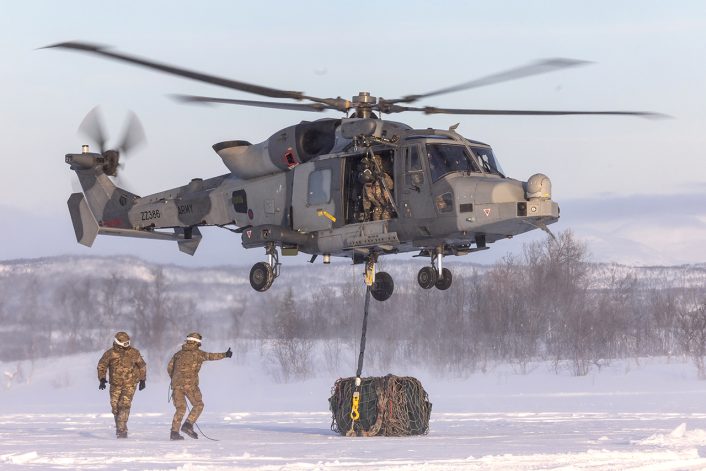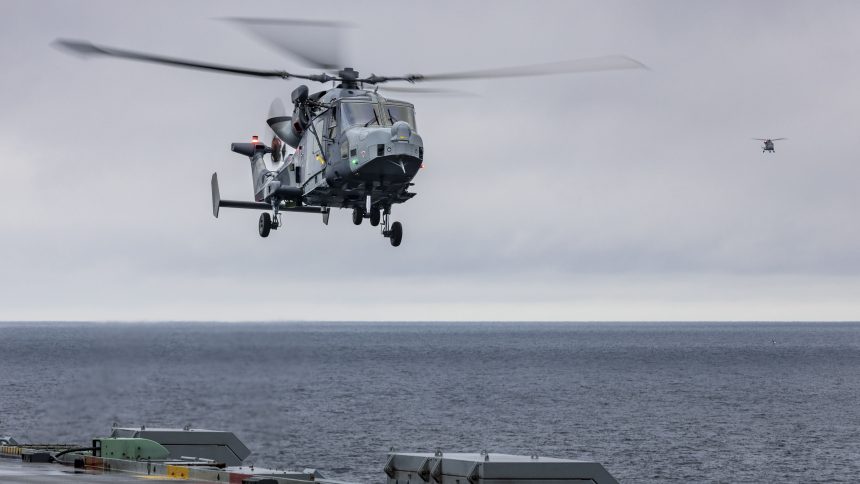Pilot Lt Dan Burnett has received a commendation from the Shipwrecked Mariners’ Society for his actions in safely recovering a Wildcat AH1 helicopter to its ship after it developed a major engine fault while carrying three medical evacuation patients.
In an incident which was previously unreported, the Royal Navy has revealed that in September 2023 one of its Wildcat AH1 helicopters, operated by 847 Naval Air Squadron, suffered a severe fault with one of its two engines while conducting a medical evacuation (MEDEVAC) of three patients from HMS Queen Elizabeth. The faulty engine became stuck at a high power setting, not responding to any input commands from the crew.
The pilot in command, Lieutenant Dan Burnett, assisted by crew members Lieutenant Stu Jump and Petty Officer Aircrewman Luke Philips, elected to return to the aircraft carrier rather than continue to their destination, a hospital in Newcastle. Due to the engine power level keeping the rotors running at a very high speed, bringing the aircraft to a slow and controlled descent was more difficult than normal, and abrupt maneuvers could have caused the rotors to overspeed and cause a complete engine failure.
Burnett’s original plan – a running landing on HMS Queen Elizabeth’s 280 metre flight deck – was scuppered upon his discovery that a clear run along the deck was obstructed by parked aircraft. This forced the crew to conduct a more traditional spot landing. After carrying out a series of careful turns on approach to the ship to reduce speed and altitude, Burnett managed to coax the helicopter into a hover alongside the deck. He then attempted to shut down the faulty engine to allow a reduction in power for landing, but the engine remained running. Only after the fuel supply to the engine was cut was the helicopter able to touch down on the deck with all crew members and the three patients unharmed.
The skill and calm under pressure of pilot Lt Daniel Burnett has been commended by @ShipwreckedSoc – an award he says acknowledges the superb effort by all the aircrew when their @847NAS Wildcat developed engine problems off @HMSQNLZ last autumn.
🔗 https://t.co/7u0pqL6YlF pic.twitter.com/FvlWLL1rnv
— Royal Navy (@RoyalNavy) October 8, 2024
In recognition of the pilot’s life-saving flying, the Shipwrecked Mariners’ Society awarded Lt Burnett an Individual Commendation for airmanship and meritorious actions in rescuing others at the society’s 2024 Skill and Gallantry Awards ceremony, held at Fishmongers’ Hall in London on Oct. 1, 2024.
Chief Executive Captain Justin Osmond remarked “Lieutenant Burnett’s exceptional technical acumen, outstanding airmanship, and calm leadership in the face of a severe emergency undoubtedly prevented a life-threatening situation from escalating”
“His quick and decisive measures protected the lives of those on board and preserved the helicopter for future operations. His remarkable captaincy during this complex emergency reflects the finest traditions of the Fleet Air Arm. Lt Burnett is fully deserving of an Individual Commendation for his heroic and exemplary actions.”
Commenting on the awards as a whole, he said “Our Skill and Gallantry Awards, which we’ve presented for 173 nears, are a testament to the incredible bravery, technical expertise, and steadfast dedication of the maritime community. Those being honoured this year have shown remarkable courage, skill and commitment to supporting seafarers in need and these awards are a celebration of their exceptional actions and the profound impact they have on our maritime community.”
Remaining humble after receiving the award, Lt Burnett noted the contribution of his fellow crew and said the award belongs to them all – “Dealing with the emergency was an absolute team effort and I was lucky to have an experienced crew: Lieutenant Stu Jump and Petty Officer Aircrewman Luke Philips were instrumental in enabling the safe recovery of the aircraft”
The Wildcat AH1
The AH1 variant of the Wildcat helicopter is operated by three squadrons of the British Army Air Corps and one squadron of the Royal Navy’s Fleet Air Arm, all based at RNAS Yeovilton in Somerset, England. It was the first Wildcat variant to be delivered to the UK armed forces and entered operational service in 2014.
Compared to the HMA2 variant, a maritime utility and attack helicopter operated exclusively by the Fleet Air Arm, the AH1 is focused on battlefield reconnaissance and transport. It lacks the Seaspray radar carried by the Wildcat HMA under the aircraft’s nose, but retains the WESCAM MX-15 electro-optical/infrared turret.
The AH1 fleet is organised under the UK’s Joint Aviation Command, a tri-service unit that coordinates all battlefield helicopters in British service. 847 Naval Air Squadron, the sole Royal Navy Wildcat AH1 unit, is also a constituent unit of the Commando Helicopter Force, which focuses on supporting operations by the Royal Marines.

It should be noted that under the UK military aircraft designation system, the abbreviation AH in this case stands for Army Helicopter, as opposed to the US system where it would mean Attack Helicopter. In the UK, usually (but not always) each aircraft type receives a designated name which covers all aircraft of that family, and then an alphanumeric suffix will denote the exact variant. Because of this, there will often be multiple aircraft in service simultaneously using the same variant suffix – for example, Wildcat AH1, Apache AH1, Gazelle AH1 and Dauphin AH1 all served concurrently with the Army Air Corps.
Unlike the Wildcat HMA2 in fact, the Wildcat AH1 has not been equipped to utilize new missile wings and associated weaponry. The armament of the Wildcat AH1 is presently limited to door-mounted guns, though it is capable of working in tandem with and designating targets for Apache attack helicopters. The AH1 variant has also been involved in testing remote operations with new unmanned aerial vehicles.

In the last few years, the UK Wildcat fleet has undergone upgrades to install Link 16 tactical datalink capability, a NATO standard system which allows for secure communications via text, voice and images across a variety of platforms. This would be vital for interoperability in the modern battlespace and reinforces the Wildcat’s battlefield reconnaissance role, as Link 16 is also used by the AH-64E Apache, Typhoon FGR4 and F-35 Lightning II, alongside many other UK operated and Allied aircraft, ships and weapon systems.
Considerations are also being made for the potential upgrade of the Wildcat AH1 to include the Seaspray 7500E V2 radar. This radar, similar to the Seaspray 7400E fitted to the HMA2, is an active electronically scanned array that is a long way from the original mechanical Seaspray radars equipped to the Westland Lynx. Its ground moving target indicator (GMTI) function would be extremely beneficial in the AH1’s battlefield reconnaissance role. The same radar has recently been integrated onto a variant of the MQ-9 Reaper.
As for the weapon wings, it is unclear whether adding these to the AH1’s arsenal is in the pipeline, or how difficult the task might be.









